|
|
CES Technical Report 133, August 2013 |
WATERSCAPE OF KERALA: CHARACTERISATION OF SURFACE, WELL AND TAP WATER IN ALL DISTRICTS |
KERALA WATER RESOURCE - THREATS AND MANAGEMENT ISSUES
Deforestation - Land use changes: Conversion of watershed area has altered the hydrological regime while enhancing the silt movement – lowering water yield in the catchment affecting the groundwater recharge. Large-scale deforestation in the Western Ghats and introduction of plantation crops in highlands replacing the natural vegetation reduced the storage capacity of soil and resulted in surface soil erosion in watersheds and sedimentation in rivers. This has affected summer flow in rivers and some perennial rivers and rivulets have became seasonal in the last few decades due to large scale land cover changes.
Sand Quarrying and River Bank Agriculture
Sand quarrying in rivers and watersheds are killing the rivers. Such activities lead to bank erosion, lowering of water table and create several environmental problems. Ground water level in some of the watersheds has gone down by nearly one meter in the last two decades. Agricultural practices in the riverbanks (and also inside the dry riverbeds) during non-rainy months also add to bank erosion and sedimentation in rivers.
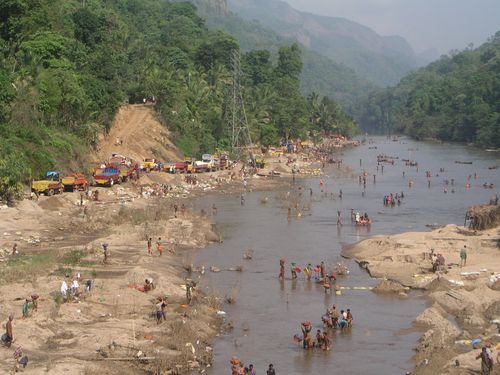
Prevalent illegal sand mining in rivers and streams
Degradation of Water Resources
All 44 rivers in Kerala are highly polluted due to inflow of untreated domestic, industrial wastes and agriculture runoff. Most of the industries are near the thickly populated riversides, often near cities and towns. There is no efficient water treatment system in industries and city municipalities. Pollution level in some of the sites is far above permissible limits.
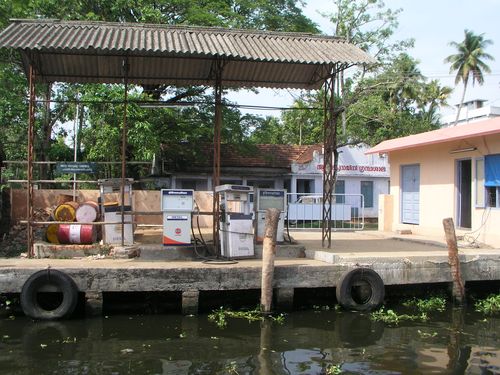
Oil spill: Water contamination
Land Reclamation and Construction: Sand filling of ponds, farmlands, wetlands and other water bodies affects natural water flow and groundwater recharge. Construction of new roads and buildings has blocked many canals, which were important for navigation and freshwater. Vast areas of wetlands and paddy fields have been converted into settlement and industrial areas in the recent times.
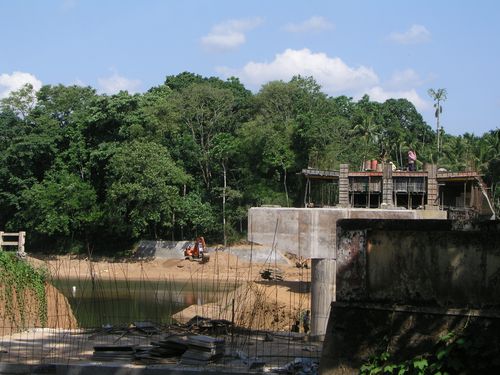
Land reclamation
Bacteriological Contamination in Drinking Water Source
Wide spread bacteriological contamination of fecal origin in sources of public drinking water supplies, viz. traditional open dug wells, bore wells and surface sources. This is confirned by the findings and public concerns expressed during site visits. Theses concerns for ground and surface water contamination relate to
- Close proximity of increasing numbers of leach pit latrines under varying soil conditions, laterite (midland) and sandy soils (coastal area);
- Non point sources of pollution in the catchment area including possible agricultural and surface run off, especially during the rainy season;
- Washing, bathing and other domestic activities around the open dug well sources, especially among the low income communities;
- Inadequate and irregular disinfection of drinking water supplies, including chlorination under KWA schemes;
- Inadequate testing and irregular monitoring of drinking water quality.
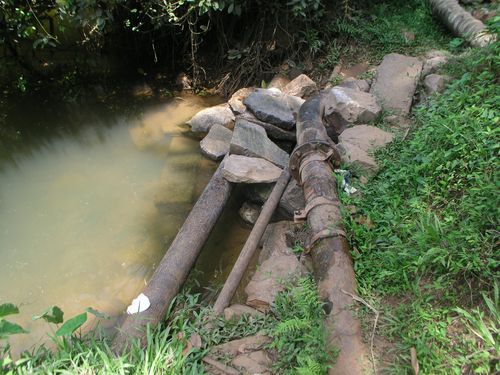
Leaky water distribution network: Source of contamination of treated water
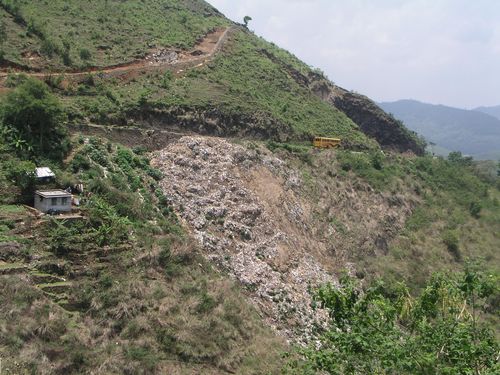
Solid waste dumping in a river catchment
MANAGEMENT WATER QUALITY ASPECTS
Effective and continuous disinfection of all drinking water supplies so as to maintain minimum residual chlorine of 0.5 mg/l. The experimental results show that the quality of drinking water supplies in the state clearly indicates high level of bacterial contamination. This poses a serious risk to public health. This is confirmed by the high incidence of acute diarrhoeal diseases and other water borne infections among the people especially the poor sections of the community. This brings out the need for a system of continuous disinfection of the water supplies. The traditional wells used as a drinking water sources are reported to be disinfected only
GROUNDWATER PROTECTION
Contamination of Groundwater is more complex than surface water pollution mainly because of difficulty in its timely detection and slow movement. In addition the complex geo-chemical reactions taking place in the subsurface between myriad contaminants and earth materials are not always well-understood. Ideally speaking contamination should be prevented from occurring. After a contaminant or several contaminants are found in groundwater, a decision must be made on whether to rehabilitate the aquifer or find alternative groundwater resources.
| Responsible Factor |
Most Probable Response |
| Groundwater pollution originating on land surface |
| Infiltration of contaminated surface water |
Contamination of stream side aquifer due to polluted stream |
| Land disposal of waste |
Contamination due to direct disposal of waste |
| Stock piles (ore) tailings (over burden dumps |
Release of mineralized leachate |
| Disposal of Sewage/Sludge |
Release of Biological mineralized leachate |
| Salt spreading on road |
Pollution due to winter time road salting |
| Animals feed lots |
Biological waste |
| Fertilizer and Pesticides |
Run-off resulting from indiscriminate use of such items |
| Accidental spills |
Spill of in-transit chemicals and contamination due to spray water used during such mishap. |
| Air borne source |
Acid/alkali rain particulates as fall out from smoke/ flue dust automobile pollutants |
| Groundwater pollution originating above the groundwater table |
| Septic tanks Cess pools |
Biological contamination of groundwater |
| Surface impoundment |
Leachate from lagoons for storage/treatment of sewage industrial wastewater oil field brines spent acids etc. |
| Underground storage tanks/pipelines |
Corrosion and /or leakage |
| Artificial Recharge |
In case of improper operation the recharge may lead to increased concentration of nitrates, metals, bacteria, viruses, detergents etc. |
| Groundwater pollution originating below the groundwater table |
| Waste disposal in wet excavations |
Contamination through abandoned mines |
| Agriculture drainage wells |
Drainage of agricultural residues from marshes /ponds |
| Well disposal of waste |
Contamination due to direct injection of waste |
| Secondary recovery of petroleum |
Migration and ingress of hydrocarbons |
| Mines |
Percolation of mine water |
| Exploratory wells and test holes |
Inter-linking of aquifers leading to dissemination of pollutants |
| Abandoned wells |
Direct migration of mineralized fluids |
| Water supply wells |
Contamination by surface run-off |
| Excessive groundwater development |
Salt water ingress |
| Classification |
Transmission |
Examples |
Preventive strategies |
| Water-borne (water-borne diseases can also be water washed |
Disease is transmitted by
ingestion |
- Diarrhoeas (e.g. cholera)
- Enteric fevers (e.g. typhoid)
- Hepatitis A
|
- Improve quality of drinking water
- Prevent casual use of other unimproved sources
- Improve sanitation
|
| Water-washed (water scarce) |
Transmission is reduced with
an increase in water quantity:
• Infections of the intestinal
tract
• Skin or eye infections
• Infections caused by lice or
mites |
Diarrhea (e.g. amoebic
dysentery)
Trachoma
Scabies |
Increase water quantity
Improve accessibility and
reliability of domestic water
supply
Improve hygiene
Improve sanitation |
| Water-based |
The pathogen spends part of
its life cycle in an animal
which is water-based. The
pathogen is transmitted by
ingestion or by penetration of
the skin. |
Guinea worm
Schistosomiasis |
Decrease need for contact
with infected water
Control vector host
populations
Improve quality of the water
(for some types)
Improve sanitation (for some
types) |
| Insect-vector |
Spread by insects that breed
or bite near water |
Malaria
River blindness |
Improve surface-water
management
Destroy insects’ breeding
sites
Decrease need to visit
breeding sites of insects
Use mosquito netting
Use insecticides |
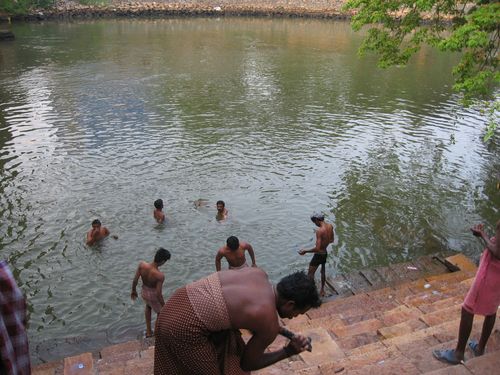
Bathing in contaminated water leads to water borne skin disease
Watershed-Based Approach to Aquatic Resource Management
Each river system - from its headwaters to its mouth - is an integrated system and must be treated as such. The focus of water resource management is on wise and efficient use of water resources for such purposes as energy production, navigation, flood control, irrigation, and drinking water (Rajinikanth, R. and Ramachandra, T.V. 2001). It also places emphasis on improving ambient water quality. Watershed approach can provide benefits to individual citizens, the public sector, and the private sector. Individual citizens benefit when watershed protection improves the environment and the livability of an area. The watershed- wide participation of local citizens and organizations ensures that those who are most familiar with a watershed, its problems and possible solutions, play a major role in watershed stewardship. The private sector can benefit because the burden of water resource protection is distributed more equitably among pollution sources.
A comprehensive approach to water resource management is needed to address the myriad water quality problems that exist today from non-point and point sources as well as from habitat degradation. Watershed based planning and resource management is a strategy for more effective protection and restoration of aquatic ecosystems and for protection of human health. The watershed approach emphasizes all aspects of water quality, including chemical water quality (e.g., toxins and conventional pollutants), physical water quality (e.g., temperature, flow, and circulation), habitat quality (e.g., stream channel morphology, substrate composition, and riparian zone characteristics),and biological health and biodiversity (e.g., species abundance, diversity, and range).
To deal with non-point source pollution in an effective manner, a smaller and more comprehensive scale of analysis and management is required. While point source pollution control programs encourage identifying isolated polluters, non-point source strategies recognize that small sources of pollution are widely dispersed on the landscape and that the cumulative impacts of these pollutants on water quality and habitat are great. A whole basin approach to protecting water quality has proved most effective because it recognizes connected sub-basins (Ramachandra T.V., 2006b). This includes
- Addressing issues of water quantity, protection of riparian areas, control of aquatic non-native species, and protection of water quality.
- Protecting the integrity of permanent and intermittent seeps, streams, rivers, wetlands, riparian areas, etc.
- Prioritising watersheds for protection and restoration and focus available resources on highest priorities. Also, identify subwatersheds in which to emphasize high water quality.
- Not implementing any timber management in riparian areas without proof that these activities actually increase coarse woody debris above natural levels and the benefits outweigh the risks (sedimentation, oil and fuel runoff, etc).
- Conducting a comprehensive all seasons water quality monitoring.
- Eliminating commercial logging and unrestrained recreation in municipal watersheds
3.2 Watershed Management Practices
Non-point source pollution poses a serious threat to the health of watersheds. It results from an accumulation of many small actions, and, although the individual impacts may seem minor, the combined cumulative effects are significant. Control measures and best management practices (BMPs) exist that can be utilized for improved watershed health (Ramachandra, T.V. 2006b). The effectiveness of the measures varies, depending on the specific pollutants addressed; the watershed hydrology and characteristics, such as soils, slopes, type of vegetative cover, and the nature and extent of area development; the waterbodies in the watershed; and the sources of the pollution. Effectiveness also depends on correct application of the control measure or practice. All types of land uses have the potential to create non-point source pollution. Most of this pollution results from changes and disturbances on the land. Some key sources include residential areas, agricultural activities and forest practices.
Residential problems stem from neighbourhoods containing typical single- or multi-family dwelling units. The problems arise from impervious surfaces that increase the flow and volume of runoff causing stream channel erosion and flooding, and from sedimentation from eroded lawns and gardens. Runoff can become contaminated by household chemicals such as fertilizers, pesticides and herbicides, paints, solvents, and street/auto contaminates like oil. The most effective control measures to address residential non-point source pollution include:
- public education
- use of vegetated swales and wetlands for contaminate filtration before runoff enters receiving streams
- sediment traps in stormwater systems
- stormwater retention (e.g. detached downspouts)
- landscape design for erosion control
- recycling and proper disposal of household chemicals and wastes
- proper maintenance of on site septic systems to reduce nutrient loading
- combined sewer overflow management
- vegetative planting and riparian enhancement of neighborhood streams
- street sweeping to reduce suspended solid loading and decrease heavy metals and phosphorus contamination to receiving streams
- planned development on steep slopes
- limited amount of impervious surface
- increased use of cluster developments
- utilization of erosion control ordinances, especially on construction sites
Agricultural Activities include land uses such as orchards, nurseries, crop production, feedlots, and grazing. Most non-point source pollution from agricultural practices comes from erosion or chemical contamination of receiving waters. The most effective control measures to address agriculture-related non-point source pollution include:
- riparian area protection and enhancement
- revised management practices for livestock grazing and manure handling
Forestry practices generally lead to nonpoint source pollution problems of soil erosion and chemical contamination. The most effective control measures to address these problems include:
- technical assistance to landowners
- limits on road building and management
- use of erosion control standards
- chemical application controls (pesticides and herbicides)
- riparian area protection and enhancement
This accentuates the need for healthier watersheds. Healthier watersheds would slow the runoff, increase percolation into underground aquifers, decrease siltation of waterways, and lengthen the flow period for the rivers.
Watershed management has worked for over a century in Tinelvelli, where watershed recovered resulting in improved stream flow in less than five years when cattle grazing and fuelwood harvest were removed. The Palni Hills Conservation Council (PHCC) found that the watersheds of the Karavakurichi Reserve Forest improved in mere two years when fuelwood harvesters were given alternate employment in tree nurseries. Similar success stories are reported from dry arid districts like Ananthpur.
Aquatic Ecosystem: Conservation Strategy
While rivers, lakes, and wetlands contain a mere 0.01% of the Earth’s water, these ecosystems support a disproportionately large part of global biodiversity. Freshwater fishes alone account for approximately one quarter of all living vertebrate species and It is estimated that there are 44,000 scientifically named species of freshwater biota. Tallies of endangered species indicate that freshwater biodiversity is generally more threatened than terrestrial biodiversity. For example, of those species considered in The World Conservation Union’s (IUCN) Red List for 2000, 20% of amphibians and 30% of fishes (mostly freshwater) were considered threatened. Freshwater biodiversity faces a broad range of threats. These include the direct impacts of dams, exotic species, overfishing, pollution, stream channelisation, water withdrawals, and diversions, as well as the indirect consequences of terrestrial activities such as logging, agriculture, industry, housing development, and mining (Prasad, et al. 2002). Conservation strategies need to be evolved and implemented to protect freshwater biodiversity. The Aquatic Conservation Strategy focus on conservation and maintaining the ecological health of watersheds and aquatic ecosystems so as to (Ramachandra, T.V. et al. 2002):
- Maintain and conserve the distribution, diversity, and complexity of watershed and landscape-scale features to ensure protection of the aquatic systems to which species, populations, and communities are uniquely adapted.
- Maintain and conserve spatial and temporal connectivity within and between watersheds. Lateral, longitudinal, and drainage network connections include flood plains, wetlands, up slope areas and headwater tributaries. These lineages must provide chemically and physically unobstructed routes to areas critical for fulfilling life history requirements of aquatic and riparian-dependent species.
- Maintain and restore the physical integrity of the aquatic system, including shorelines, banks, and bottom configurations.
- Maintain and preserve water quality necessary to support healthy riparian, aquatic, and wetland ecosystems. Water quality must remain in the range that maintains the biological, physical, and chemical integrity of the system and benefits survival, growth, reproduction, and migration of individuals composing aquatic and riparian communities.
- Maintain the sediment regime under which an aquatic ecosystem evolved. Elements of the sediment regime include the timing, volume, rate, and character of sediment input, storage, and transport.
- Maintain in stream flows sufficient to create and sustain riparian, aquatic, and wetland habitats and to retain patterns of sediment, nutrient, and wood routing (i.e., movement of woody debris through the aquatic system). The timing, magnitude, duration, and spatial distribution of peak, high, and low flows must be protected.
- Maintain the timing, variability, and duration of flood plain inundation and water table elevation in meadows and wetlands.
- Maintain and conserve the species composition and structural diversity of plant communities in riparian zones and wetlands to provide adequate summer and winter thermal regulation, nutrient filtering, appropriate rates of surface erosion, bank erosion, and channel migration, and to supply amounts and distributions of coarse woody debris sufficient to sustain physical complexity and stability.
- Maintain and conserve habitat to support well-distributed populations of native plant, invertebrate, and vertebrate riparian-dependent species.
- Aquatic ecosystem conservation and management require collaborated research involving natural, social, and inter-disciplinary study aimed at understanding the various components, such as monitoring of water quality, socio-economic dependency, biodiversity, and other activities, as an indispensable tool for formulating long term conservation strategies (Ramachandra, 2005). This requires multidisciplinary-trained professionals who can spread the understanding of ecosystem’s importance at local schools, colleges, and research institutions by initiating educational programs aimed at raising the levels of public awareness and comprehension of aquatic ecosystem restoration, goals, and methods.
- Actively participating schools and colleges in the vicinity of the waterbodies may value the opportunity to provide hands-on environmental education which could entail setting up laboratory facilities at the site. Regular monitoring of waterbodies (with permanent laboratory facilities) would provide vital inputs for conservation and management.
Watershed restoration should be an integral part of the conservation program to aid recovery of habitat, riparian habitat, and water quality. The most important components of a aquatic restoration program are control and prevention of pollution and sediment production, restoration of the condition of riparian vegetation, and restoration of in-stream habitat complexity (Ahalya, N. and Ramachandra, T.V. 2001).
Restoration of Aquatic Ecosystems
Due to various anthropogenic activities to cater the needs of growing population, the degradation of freshwater ecosystems by a variety of stressors has increased logarithmically. As a result, many aquatic ecosystems are in need of some drastic corrective measures / restoration. Restoration is the "return of an ecosystem to a close approximation of its condition prior to disturbance" or the reestablishment of predisturbance aquatic functions and related physical, chemical and biological characteristics. It is a holistic process not achieved through the isolated manipulation of individual elements. The objective is to emulate a natural, self-regulating system that is integrated ecologically with the landscape in which it occurs. Often, restoration requires one or more of the following processes: reconstruction of antecedent physical conditions, chemical adjustment of the soil and water; and biological manipulation, including the reintroduction of absent native flora and fauna. These principles focus on scientific and technical issues, but as in all environmental management activities, the importance of community perspectives and values is to be considered. Coordination with the local people and organizations that may be affected by the project can help build the support needed to get the project moving and ensure long-term protection of the restored area. In addition, partnership with all stakeholders can also add useful resources, ranging from finance and technical expertise to volunteer help with implementation and monitoring (Ramachandra T.V. 2001). Restoration principles are
- Preserve and protect aquatic resources: Existing, relatively intact ecosystems are the keystone for conserving biodiversity, and provide the biota and other natural materials needed for the recovery of impaired systems.
- Restore ecological integrity: Ecological integrity refers to the condition of an ecosystem -- particularly the structure, composition, and natural processes of its biotic communities and physical environment.
- Restore natural structure: Many aquatic resources in need of restoration have problems that originated with harmful alteration of channel form or other physical characteristics, which in turn may have led to problems such as habitat degradation, changes in flow regimes, and siltation.
- Restore natural function: Structure and function are closely linked in river corridors, lakes, wetlands, estuaries and other aquatic resources. Reestablishing the appropriate natural structure can bring back beneficial functions.
- Work within the watershed and broader landscape context: Restoration requires a design based on the entire watershed, not just the part of the waterbody that may be the most degraded site. Activities throughout the watershed can have adverse effects on the aquatic resource that is being restored. By considering the watershed context in this case, restoration planners may be able to design a project for the desired benefits of restoration, while also withstanding or even helping to remediate the effects of adjacent land uses on runoff and non-point source pollution.
- Understand the natural potential of the watershed: Restoration planning should take into account any irreversible changes in the watershed that may affect the system being restored, and focus on restoring its remaining natural potential.
- Address ongoing causes of degradation: Identify the causes of degradation and eliminate or remediate ongoing stresses wherever possible.
- Develop clear, achievable, and measurable goals: Goals direct implementation and provide the standards for measuring success. The chosen goals should be achievable ecologically, given the natural potential of the area, and socio-economically, given the available resources and the extent of community support for the project.
- Focus on feasibility taking into account scientific, financial, social and other considerations.
- Anticipate future changes: As the environment and our communities are both dynamic, many foreseeable ecological and societal changes can and should be factored into restoration design.
- Involve the skills and insights of a multi-disciplinary team: Universities, government agencies, and private organizations may be able to provide useful information and expertise to help ensure that restoration projects are based on well-balanced and thorough plans.
- Design for self-sustainability: Ensure the long-term viability of a restored area by minimizing the need for continuous maintenance of the site. In addition to limiting the need for maintenance, designing for self-sustainability also involves favoring ecological integrity, as an ecosystem in good condition is more likely to have the ability to adapt to changes.
- Use passive restoration, when appropriate: Simply reducing or eliminating the sources of degradation and allowing recovery time will allow the site to naturally regenerate. For some rivers and streams, passive restoration can reestablish stable channels and floodplains, regrow riparian vegetation, and improve in-stream habitats without a specific restoration project. Passive restoration relies mainly on natural processes and it is still necessary to analyze the site's recovery needs and determine whether time and natural processes can meet them.
- Restore native species and avoid non-native species: Many invasive species outcompete natives because they are expert colonizers of disturbed areas and lack natural controls.
- Use natural fixes and bioengineering techniques, where possible: Bioengineering is a method of construction combining live plants with dead plants or inorganic materials, to produce living, functioning systems to prevent erosion, control sediment and other pollutants, and provide habitat. These techniques would be successful for erosion control and bank stabilisation, flood mitigation, and even water treatment.
- Monitor and adapt where changes are necessary: Monitoring before and during the project is crucial for finding out whether goals are being achieved. If they are not, "mid-course" adjustments in the project should be undertaken. Post-project monitoring will help determine whether additional actions or adjustments are needed and can provide useful information for future restoration efforts. This process of monitoring and adjustment is known as adaptive management. Monitoring plans should be feasible in terms of costs and technology, and should always provide information relevant to meeting the project goals.
These principles focus on scientific and technical issues, but as in all environmental management activities, the importance of community perspectives and values should not be overlooked. The presence or absence of public support for a restoration project can be the difference between positive results and failure. Coordination with the people and organizations that may be affected by the project can help build the support needed to get the project moving and ensure long-term protection of the restored area (Ramachandra, T.V. et al. 2002). Thus, a sustainable water system encompass issues such as:
- Environment: watershed protection, ecosystem balance, waste-water and bio-solids
- Community: sufficient and reliable water supply, participation in planning and recreational use to water.
- Economy: Evolution and diversification, Sustainable and long-term growth.
Within this overall vision, water management system will require, among other steps, the following action to be taken:
- Through strategic partnerships among national agencies, provincial agencies and local/city departments
- Developing alternate water sources - reclaimed/treated water, desalination, rainwater and water reuse.
- Implementing new technologies for water fees/metering, leak detection and water auditing systems
- Engage the community through education, local and regional planning processes and outreach to cultural and community groups.
- Scientific investigations involving aquifer monitoring, coastal marine environment study, supply-demand forecasting and pollution prevention.
The principal components of water management system include:
- Supply optimization, including assessments of surface and groundwater supplies, water balances, wastewater reuse, and environmental impacts of distribution and use options.
- Demand management, including cost-recovery policies, water use efficiency technologies, and decentralized water management authority.
- Equitable access to water resources through participatory and transparent management, including support for effective water users association, involvement of marginalized groups, and consideration of gender issues.
- Improved policy, regulatory and institutional frameworks, such as the implementation of the polluter-pays principle, water quality norms and standards, and market-based regulatory mechanisms.
- Intersectoral approach to decision-making, combining authority with responsibility for managing the water resource.
Water quality and quantity are becoming increasingly critical factors of socioeconomic development in many parts of the world. One of the milestones in managing international and transnational water resources and boundaries was the meeting and agreement on transboundary water management signed in Helsinki in the 1966 (ILC Helsinki 1966).
Helsinki rule evolved by the International law association in 1966 (see Annexure I) are:
- the geography of the basin including, in particular, the extent of the drainage area in the territory of each basin state;
- the hydrology of the basin including, in particular, the contribution of water by each basin state;
- the climate affecting the basin;
- the past utilization of the waters of the basin, including in particular, existing utilization;
- the economic and social needs of each basin state;
- the population dependent on the waters of the basin of each state;
- the comparative costs of alternative means of satisfying the economic and social needs of each basin state;
- the availability of other resources;
- the avoidance of unnecessary waste in the utilization of the waters of the basin;
- the practicability of the compensation to one or more of the co-basin states as a means of adjusting conflicts among users; and
- the degree to which the needs of a basin state may be satisfied without causing substantial injury to a co-basin state.
|





